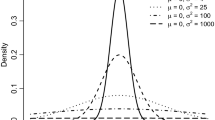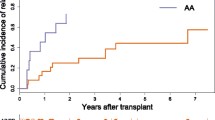Abstract
We analyze left-truncated and right-censored data using Cox proportional hazard models with long-term survivors. The estimators of covariate coefficients and the long-term survivor proportion are obtained by the partial likelihood method, and their asymptotic properties are also established. Simulation studies demonstrate the performance of the proposed estimators, and an application to a real dataset is provided.
Similar content being viewed by others
References
Andersen, P.K., Borgan, B., Gill, R.D., Keiding, N. Statistical Models Based on Counting Processes. Springer-Verlag Press, New York, 1993
Andersen, P.K., Gill, R.D. Cox’s regression model for counting processes: a large sample study. The Annals of Statistics, 10: 1100–1120 (1982)
Farewell, V.T. The use of mixture models for the analysis of survival data with long-term survivors. Biometrics, 38: 1041–1046 (1982)
Farewell, V.T. Mixture models in survival analysis: are they worth the risk? Canadian Journal of Statistics, 14: 257–262 (1986)
Hyde, J. Survival analysis with incomplete observations. Biostatistics, 30: 31–46 (1980)
Klein, J.P., Moeschberger, M.L. Survival Analysis: Techniques for Censored and Truncated Data. Springer-Verlag Press, New York, 2002
Kuk, A.Y.C., Chen, C.H. A mixture model combining logistic regression with proportional hazards regression. Biometrika, 79: 531–541 (1992)
Lu, W. Maximum likelihood estimation in the proportional hazards cure model. Annals of the Institute of Statistical Mathematics, 60: 545–574 (2008)
Maller, R.A., Zhou, X. Survival Analysis with Long-term Survivors. Wiley, Chichester, 1996
Peng, Y., Dear, K.B.G. A nonparametric mixture model for cure rate estimation. Biometrics, 56: 237–243 (2000)
Struthers, C.A., Farewell, V.T. A mixture model for time to AIDS data with left truncation and an uncertain origin. Biometrika, 76: 814–817 (1989)
Sy, J.P., Taylor, J.M.G. Estimation in a Cox proportional hazards cure model. Biometrics, 56: 227–236 (2000)
Tsodikov, A.D. Estimation of survival based on proportional hazards when cure is a possibility. Mathematical and Computer modelling, 33: 1227–1236 (2001)
Tsodikov, A.D., Ibrahim, J.G., Yakovlev, A.Y. Estimating cure rates from survival data. Journal of the American Statistical Association, 98: 1063–1078 (2003)
Wang, M.C., Brookmeyer, R., Jewell, N.P. Statistical models for prevalent cohort data. Biometrics, 49: 1–11 (1993)
Woodroofe, M. Estimating a distribution function with truncated data. The Annals of Statistics, 13: 163–177 (1985)
Yamaguchi, K. Accelerated failure-time regression models with a regression model of surviving fraction: an application to the analysis of “permanent employment” in Japan. Journal of the American Statistical Association, 87: 284–292 (1992)
Zhao, X., Zhou, X. Proportional hazards models for survival data with long-term survivors. Statistics and Probability Letters, 76: 1685–1693 (2006)
Author information
Authors and Affiliations
Corresponding author
Additional information
Zhou’s work was supported by the following funding bodies: Natural Science Funds for Distinguished Young Scholar (No. 70825004), Creative Research Groups of China (No. 10721101), Shanghai University of Finance and Economics Project 211 Phase III and Shanghai Leading Academic Discipline Project (No. B803).
Zhang’s work was supported by Graduate Creation Funds of Shanghai University of Finance and Economics (No. CXJJ-2011-436).
Rights and permissions
About this article
Cite this article
Zhang, Fp., Zhou, Y. Analyzing left-truncated and right-censored data under Cox models with long-term survivors. Acta Math. Appl. Sin. Engl. Ser. 29, 241–252 (2013). https://doi.org/10.1007/s10255-013-0215-5
Received:
Revised:
Published:
Issue Date:
DOI: https://doi.org/10.1007/s10255-013-0215-5




